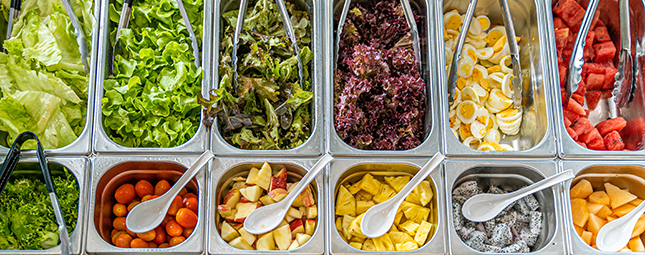Reducing food waste at the salad bar

Salad bars are vital in high-volume operations. The salad bar concept allows the kitchen to feed a lot of guests with the least amount of labor cost. It gives guests the ability to customize their meals. It offers chefs a way to utilize and repurpose ingredients in a creative and efficient manner. There are many positives to salad bars, but standard displays and operating procedures can also lead to massive amounts of food waste.
It’s the challenge with any display: it has to look attractive, and the default is to accomplish that by making it look bountiful. Filling baskets full of bread. Putting out large serving trays and keeping them full until close.
When you put out a lot of food, you are creating the opportunity for more food to go to waste.
Merchandising smarter — with creative displays that are visually appealing, but rely on less food on display — is the way to go.
A few best practices:
- Shrink as demand shrinks: Reduce salad bar lines from two to one, when ending service. Instead of the potential for two pans of food waste, the potential shrinks to one pan.
- In the last 30 minutes, consider only offering composed salads.
- You should shrink pan size as demand shrinks.
- With bread service, avoid “baskets” that require piles of food. Merchandise on flat surface in well organized — and visually appealing — rows.
- Repurpose foods from the main menu on the salad station. Think proteins and composed salads. The salad bar becomes a driver for reducing waste from other areas of service.
- Collect data on the most commonly used and eaten items, eliminate the items that aren’t eaten often.
- Keep items separate so there is a better opportunity to repurpose those items if not used.
- Avoid menuing items that are only on the salad station. Cross utilize items that are already in use somewhere else on the menu.
One Leanpath client tested an interesting approach. They shrunk pan sizes from the beginning of service to create less opportunity for waste. But the increased burden on labor to keep the smaller pans full also needed to be addressed. They updated their equipment, switching from an iced salad bar to a refrigerated bar, with refrigerated holding beneath the display. Restocking became much easier and faster because they kept items for restocking in the refrigerated holding cabinets.
The change was dramatic: with smaller pans and easier restocking, waste from the salad bar dropped nearly 80 percent.
Everyone might not be able to swap equipment, but incorporating a few simple changes can still deliver food waste reduction at the salad bar.
Download these guides and get started
on your food waste prevention journey today!
 |
 |
 |
| 20 Waste Cutting Tips Every Foodservice Chef Should Know | Preventing Food Waste at the Buffet: A Guide for Chefs & Managers | Empowering & Engaging Culinary Teams to Prevent Food Waste |